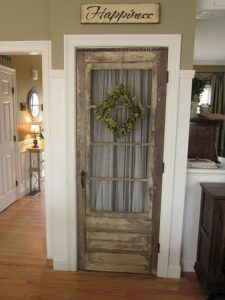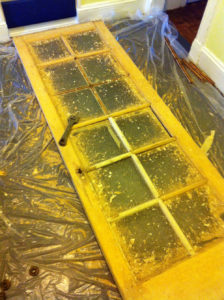A while ago I watched something go down on a build and it really stuck in my head. Following the instructions of the boss, a carpenter spent an entire day cleaning, repairing, prepping and painting a door for a Tiny House. Don’t get me wrong, it was a nice door. Salvaged from an old house, it was solid wood and very well built. But it was the wrong size, wrong color and swung the wrong way. The boss was so keen on using this door he got for a song, that he spent 2x more on labor than a new door would have cost.
Basic interior doors are pretty cheap. $30 and up.
Even solid wood ones aren’t that crazy. $169 and up.
Now let’s look at the labor he put into that door:
$25/hour x 8 hours = $200 in labor. For a business, there is at least $5 an hour in extra costs associated with the wage, so really the business owner paid $240 to turn a salvage door into something that honestly didn’t look as good as a new, solid wood door would have been.
Sure, salvage can lead to some amazing results, like this:

But don’t forget, to get there you’ve got to pass through this:

Over and over, I see people discounting the time and labor put into salvage materials. Sure, your time is available to you, free of charge, but you need to do the mental calculation to decide when it’s worth it. I’ve seen people scrounging for 2×4 scraps on construction sites. Their hour of time and the gas they’ve burned is barely worth it, as an entire 2×4, 8ft long is worth less than $5. Sure, you can find salvage siding for cheap on Craigslist, but never forget to calculate the time you spent searching, checking out materials, picking it up, storing it and prepping it when you decide if it’s worth it. If you’re going to use salvage materials, do it for the way they look, or focus on smaller, high value materials. In my garage, I have a bin of basically all the electrical materials required for a future build. In one rubbermaid bin I have receptacles, switches, device boxes and breakers that probably add up to $1,000. I probably paid $100 for everything and picked it up with my car on the way home from a job. An equivalent sized bin of wood scraps might be worth $25.
Another trap to not fall into is using materials simply because you have them. The time and energy you put into making something worth is often more than it would have taken to simply buy the correct materials or items. I’ve watched someone’s fight for two hours to make a faucet work, simply because they had it, resulting in a finished product that just didn’t work, being too short for the sink. The cost of that plumber’s additional time would have paid for a beautiful new faucet.
We all have read about people claiming they “built a tiny house for only $15,000!” but the reality is, they paid $15,000 plus used $10,000 of volunteer labor and used 1200 hours of their own time. We’ve all heard it, time is money, and even if they worked at McDonald’s, that 1200 hours would have brought them $14,000 of income, after taxes. All of a sudden, it becomes a $40,000 Tiny House. Factor in that it’s very likely they make more than the minimum wage and the actual cost to them of that Tiny House creeps up even more. Don’t get me wrong, the build is part of the experience and the feeling of making something with your own hands is incredible, but it’s important to choose your battles and finding the right balance of salvage and purchased materials is a key part of that battle.
To recap, here’s a list of the things that we have found can be worth it to salvage:
- Windows: If you are dying for wood windows or high quality metal or vinyl windows, salvage windows can be much more affordable but be sure to check them very carefully and try to learn the brands and construction methods.
- Electrical parts & equipment: Breakers, device boxes, receptacles, switches (especially dimmer switches, which can be pricey) and heavier gage wire. While some of the individual parts are cheap, the fact they can be stored easily and are fairly universal makes it worthwhile.
- Appliances: A used fridge or propane range can save you a decent amount of money.
- Flooring: A Tiny House uses such a small amount of flooring that you can occasionally get remainder lots of high quality flooring on the cheap.
And what NOT to get salvage:
- Your trailer: I once spent three entire days working on a salvage trailer with a wire wheel and grinder. We then had to flip it, work more, have a welder modify several parts before we painted the entire thing. It was a nightmare and ended up being a real hinderance to the build design. All told we probably saved $1,500 after labour costs and got a substandard trailer.
- Roofing materials: Your roof can be the most important part of your unit. Don’t take chances!
- Skylights: Skylights can be a nightmare, doubly so if they are used and possibly leak. We’ve had this happen and it ruined some beautiful flooring
- Basic dimensional lumber: Lumber is cheap. So cheap that it’s not worth the time and energy to go scrounge it up from construction sites. Save your time and energy and get them to deliver an extra 20 eight foot 2x4s when they deliver your materials. It’s $100 well spent.
- Plumbing & gas materials: Imagine the feeling when you pressure test your water system and it leaks air like crazy. Imagine the time spent spraying the entire water system with soapy water to find the leak and realizing your salvage PEX piping had a tiny pinhole in it. Then be grateful you hadn’t sealed the walls. Repeat this with gas and you get what I mean.
Done properly, salvage CAN be worth it, if you know what to salvage and what to leave on the side of the road…
